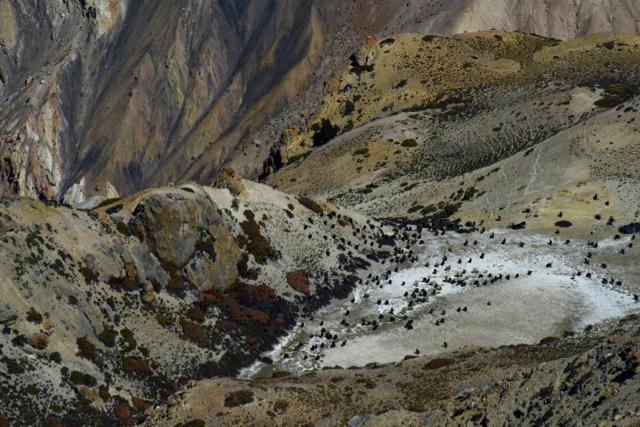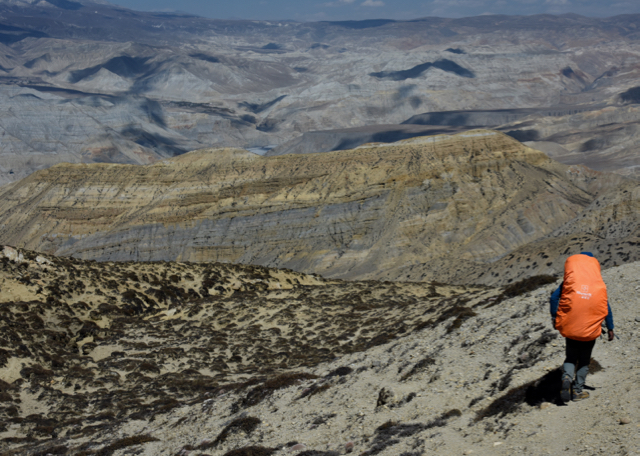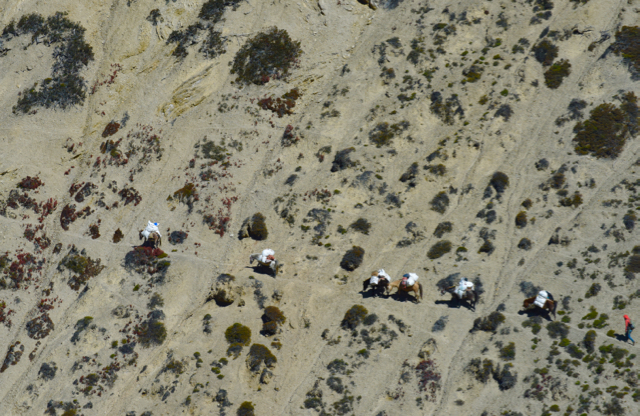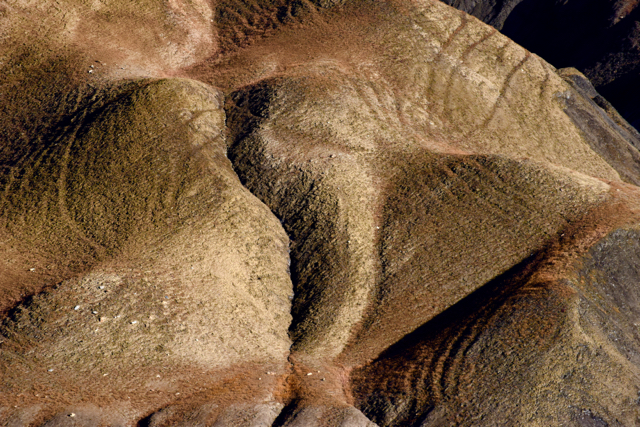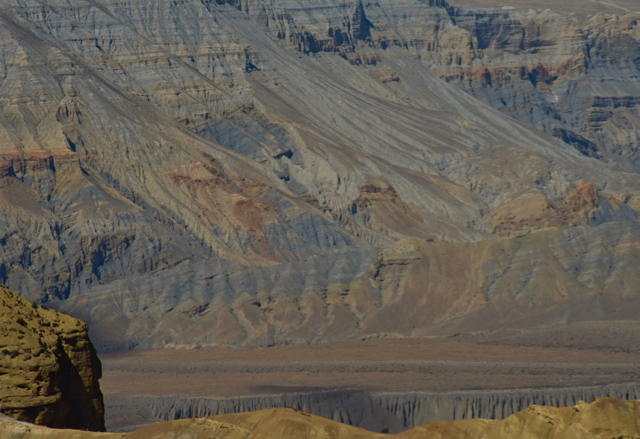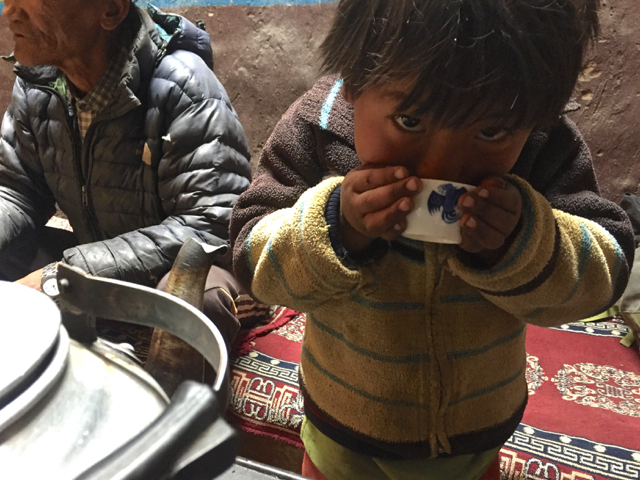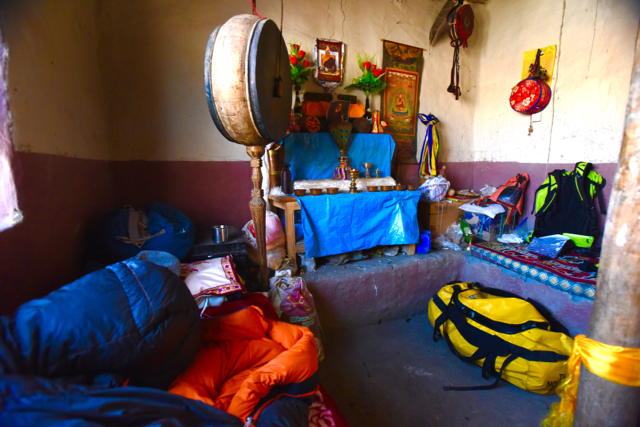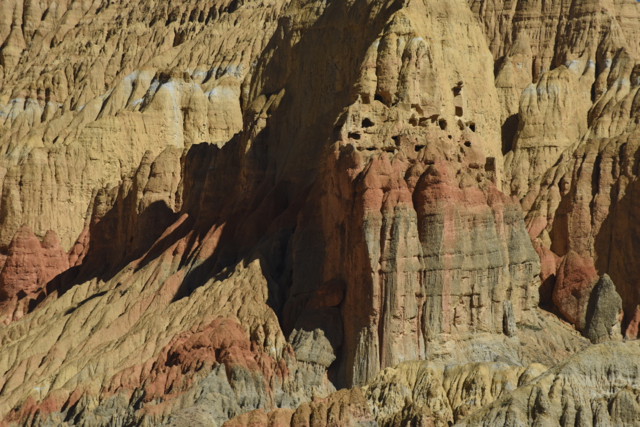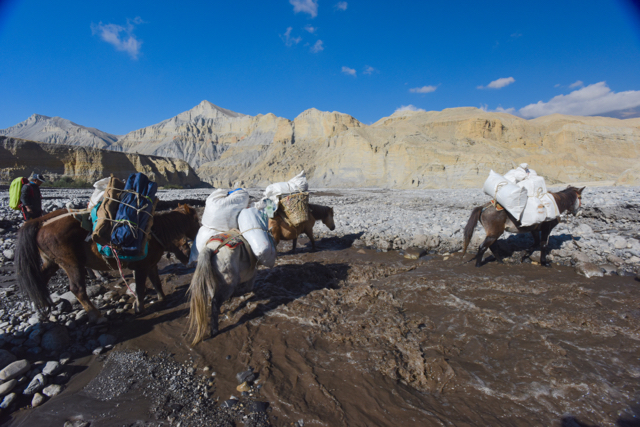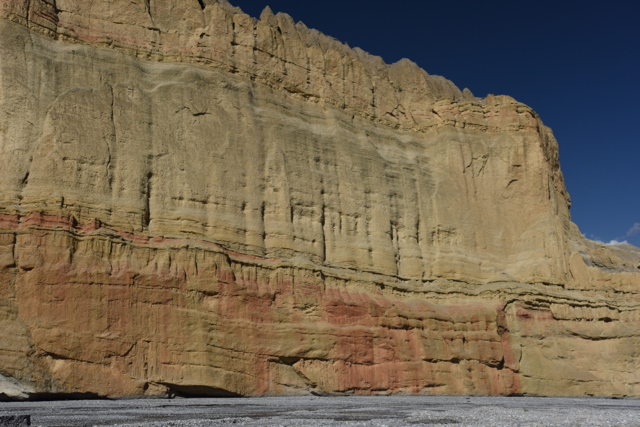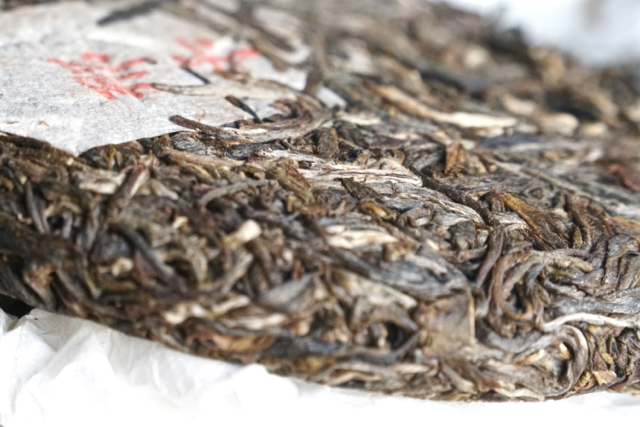The Tibetan term ‘gtum mo’, pronounced “Tummo” refers to the tantric tradition of meditation that summons or produces heat and a kind of blissful warmth within the body. It is a kind of yogic heat, which is attained through a practice that involves hyperventilation and visualization and it is one of the many practices of these mountains.
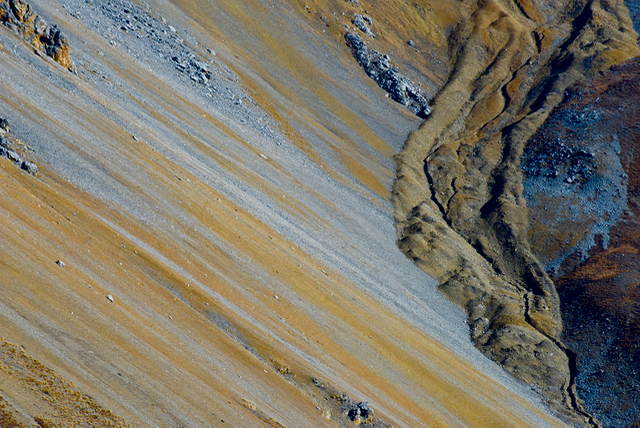
One of the many gifts that they eyes can feast on in Mustang. Perception and perspective are everything.
Living with elements that aren’t simply static cold spaces inspired such practices to find adaptive methods by which to live in the highest of high lands. The practice is a function of the mind triggering the body, in which blood and breath are channeled and funnelled. Such is the space and culture of the land we move through…when we move. So much within these mighty cold spaces has been about finding a way and that way inevitably harnessed the mind as much as the body. These ‘ways’ have been around for centuries being passed down, being coveted, and even refined because they work. In a place of such physical presence, it is the mind that still is trained to adapt.
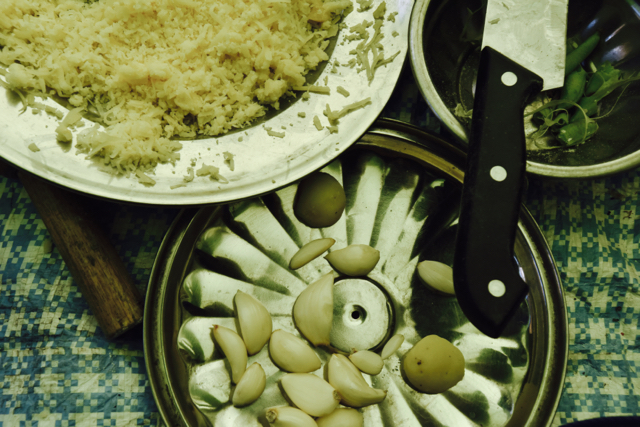
One of the ‘sacred’ needs, garlic. Garlic, tea, and lentils make up the sacred triad of consumable daily pleasures.
It is a blend of movement and stillness up here. These two props are more vital than any layers of fabric or fire in the mountains. The winds here find one under layers, within tents, behind walls. Winds here seek out bodies and objects as they pound and shriek demanding impact. The noon time winds bring dust and silt from further down in the Kali Gandaki, while the six o’clock furies are largely cold blasts before an even colder layer of still blanketing cold arrives with the nightly descents of dark. One can mark time with these winds’ and their arrivals and departures.
Tea soothes as it always does for me – both in its warmth and its ability to whittle its way into the deeper core with its stimulants. The ritual of preparation (and here that ritual is as simple as snagging clump of Puerh and putting it into a vessel to await hot water) remains the comfort that it always has been for me. Our team huddles nightly in the precious kitchen tent, which is the only tent that really matters. Spices and calories are forged together within and served up by Kiran, and our propane stove heats up the few square metres where we all can jam in and entwine in a very temporary ‘heat’.
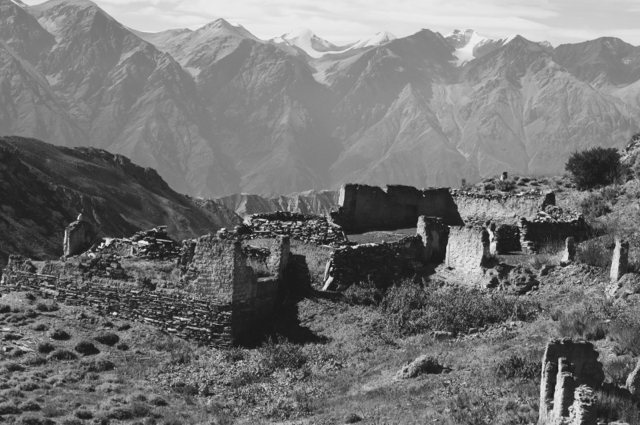
The view facing west of one of the Khampa Camps, which sits perched in a valley, forgotten except by the winds.
Debra remains on horseback and we’ve passed through the wind-blasted remains of an old Khampa resistance camp. Walls, pummeled by winds and snow lie gracefully disintegrating. The mind cannot help but travel back to when Khampa units were being trained within such compounds. As always too, Debra and I scan for water and sources…every camp and community however small would need a source for water. In the case of one of the Khampa camps, the water source would appear to have been a small valley that hosted glacier streams, that now lies as a dry V wedge.
We have moved over a ‘short cut’, a term used by Abu, with a grin. It is a straight up kind of short cut that is shorter in time if the lungs and legs will agree. Abu has the long lean body of many of the old Tibetan traders. Small of calf, slightly stooped forward and honed into a hard competent shell after a youth in the mountains’ trails accompanying his rampant herds of goats, he is a perfect host for these lands. He looks Khampa to me with his size but he assures me that he is a ‘Loba’, a local. His short cuts are entertaining and they are always accompanied with a smile. Even his horse, Ola, seems at times perplexed with these ‘straight up’ journeys. Risks up here do not come from avalanches or losing a hand grip. They come from a slip off of a path down a few hundred metres. Risks come while staring at the marvel of a one foot wide pathway with a sheer breakaway drop to one side.
This eastern flank is a at times a series of miniscule pathways that open up onto plateaus that shimmer and gleam with tones of mineral-rich earth. Travel is a comfortable daisy chain as we spread out to be in our own spaces, crimping up when we need company or to keep an eye on one another.
Khampa camp (many of the camps are thus named) is a small deep valley where the light dims early. We are tucked away from everything in a cocoon and as the light fades we are gifted a show of Bharal, the Blue Sheep, as they traipse in a long angled parade high to the east of us. The light touches their bodies, while I wonder if their nemesis, and great watcher, the Snow Leopard, rests somewhere up beyond us all waving its long tail contemplating all of us.
Our horseman Dhrabinder is a being to watch. To look at his rough outward self, one would think that he is a kind of selfless youth who cares not a bit for comforts. A thatch of peroxided hair stands tall and a ubiquitous orange-red jacket mark him and his long strides. He wears sandals and his feet are like two blocks of petrified wood. To watch him thoroughly though, one takes in a being of compassion and a love of his animals. Never does he leave their side. His whistles at times shriek, but his abilities and care are evident and the animals themselves sense this. He is a genuine hardman – a man not afraid to be gentle while carrying the marks and abilities of the mountains he lives and breaths. He takes small cigarette breaks, smoking with a kind of grace and elegance. His eyes at times glow with a kind of ethereal high of simply being in motion and respected (or at least this is what is in my mind while I watch him). Mountains do this too…they set the mind alight.
Mountains offer up a kind of freedom and space to admire both a thin-aired space of magnificent isolation and a world of characters who cope (or not). Mountains remain one of the great editors and they and their elements hone beings down to their core. I’ve seen them casually unhinge folks and dredge up long hidden inspiration in others. Mountains are far less punishing to some than they are to others.
Tangye is a village that suffers from water shortages. Like so many of the communities on the eastern flank of the Kali Gandaki, Tangye still struggles to adapt to the quickly changing patterns of rainfall. A local elder, who is in charge of maintaining water in the town takes in a grand total of 5000 Rupees a year. He is tired, undertrained and entirely baffled not by change so much, as the speed of it. He laments the nomadic life of movement that most in the region adhered to not so long ago. He laments a time when “we moved and that was our purpose”.
As we sit in a home, reconfiguring kit, eating, and becoming reacquainted with walls, I serve tea to this elder who struggles to adapt or to understand water issues and the changing climate. Just months ago the ‘monsoon’ rains that usually fell over the course of the summer, this year came in a brutal deluge in two and a half weeks. He speaks quickly and with certainty not only about water, but about mountains and his life bound to them. He speaks with an assurance of someone who knows that the water supply isn’t a distant reservoir or series of pipes, but rather sources that lie within easy sight and reach.
As I serve him tea, his young grandson takes the cup meant for his grandfather, gently cupping the little ceramic thimble in both hands and takes a sip. He takes many more sips; so much so that his grandfather gives up the notion that he will be able to share of the fluid.
We cut across the Kali Gandaki at Tangye cutting west and north crossing and re-crossing the glacier fed streams which often corkscrew down into great muddy torrents.
We head towards Tsarang, or Charang, the ancient capital of Lo (Mustang). Capitals (even ancient ‘former’ capitals) are still hubs where the memories reside of another time. Center points of culture, trade, information and of pilgrimage routes, one has only to dig a little into the memories of locals to find traces of a world just behind the veil of the present tense. Like everywhere, so much of the spaces here are informed by what has come before.
Up on ridges, on flat stone faces high above us, the telltale lines and carved out window circles stare down at us from communities that lived within stone. Abu speaks of a time where the water levels were much higher offering up a more reasonable access point to such communities. Meditation caves and deities were etched into solitary caves that now sit in silence far above us. Mountains were not risks here, they were guardians. Mountains here were homes.
As a team we are once again spread over a kilometer or so of space. Sun and wind are constants, along with the sometimes improbable pathways that have for centuries linked communities throughout the greater Kali Gandaki region.
While journeying through mountains, I’ve often thought about the significant contributions that the natural elements have made, both directly and indirectly. The elements have informed the psychology as much as they have the expanded rib cages and enhanced haemoglobin levels. Fates are at work here, and the ‘forces’ of spirit and wind revered. Long days and the sun and winds have long informed every single decision made.
Treading up another of the short cuts that Abu suggests (though he himself doesn’t take it) I realize at one point that I’m clinging to a 50-60 degree slop of crumbling stones that seems more goat trail than human. I end up doing a variation of a crab walk to ensure I stay bound to the side which drops into water…and a nice bed of rocks.
As winds pick up my mind saunters back to the little grandson, who took my offering of tea back in Tangye. I think back to him carefully taking one of my ceramic cups with a blue raven on it with two hands, and how gently he sipped the tea. For whatever reason, the image stays in my mind replaying and looping like a scene that can not be stopped. In his little sun kissed hands that cup had rarely, if ever, been so securely and gently held.

